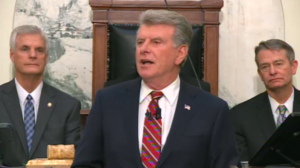(UPDATED, 10:32 a.m. Monday, with comments from the governor’s office.)
Here’s about a $3.2 million nugget of news, overshadowed by the other drama from Thursday’s Idaho Education Network budget presentation.
Gov. Butch Otter wants a $10.5 million budget for the high school broadband project in 2015-16. When Otter unveiled his 2015-16 budget request on Jan. 12, his staff outlined two budget line items totaling $7.3 million. (We reported that number on Jan. 12 and have used it for almost a month, and we’re not alone; it’s also been reported by the Spokane Spokesman-Review, the Idaho Statesman, the Associated Press and the Twin Falls Times-News.)

But come Thursday, the $10.5 million number appeared in the Department of Administration’s PowerPoint presentation.
More importantly, the number also appears in the Division of Financial Management’s executive budget, which Otter submitted to legislators on Jan. 12. (The executive budget outlines agency requests in minute detail; for the breakdown on the Idaho Education Network budget, click on the link and scroll to Section F-21.)
What’s the explanation?
In an email Monday morning, Otter spokesman Jon Hanian said the $7.3 million does not include “base funding” for the project — standard practice in discussing budget recommendations.
“The base amount is assumed,” Hanian said. “So it’s not really accurate to say it is a discrepancy.”
Program maintenance comes to nearly $2.9 million — accounting for most of the $3.2 million difference.
Here’s how the $10.5 million breaks down:
- $6,717,500 to replace federally administered “e-Rate” dollars. These funds have been on hold since March 2013, as the result of the extended legal battle over the existing network contract. The Administration Department is pursuing a one-year “bridge contract” in hopes of restoring e-Rate payments. But that may not happen, Otter education adviser John Goedde told legislative budget-writers Thursday, so he said the state should plan on paying its own way.
- $2,889,000 for program maintenance.
- $580,000 to accommodate growth, as some new high schools come onto the system, and other schools increase their bandwidth use.
- $176,000 for teacher stipends and training.
- $165,000 in one-time money to purchase additional video teleconferencing systems.
- $12,000 for equipment installation.
